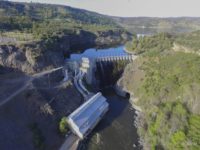 AP Elwha Dam, built without fish ladders, blocks a run where salmon weighed up to 100 lb.
|
By issuing a state water-quality permit, Washington state has removed a critical hurdle for the National Park Service to demolish two large dams in Olympic National Park. Remaining permits are expected to be in place by the end of April.
By removing the dams, the park service will reopen a legendary salmon run blocked for nearly a century. It aims to begin demolition by late 2009, pending construction of two water treatment plants.
Washington’s Dept. of Ecology issued the permit to take down Elwha and Glines Canyon dams, built in 1913 and 1927, respectively, to power a paper mill. The Denver Service Center, the park service’s construction arm, will act as construction manager on the treatment plants and plans to solicit bids in early summer.
One is a $12- to $25-million municipal drinking-water plant for the city of Port Angeles, Wash., with a capacity of 11 million gallons per day. The other is a $60-million to $80-million wastewater treatment plant that serves two fish hatcheries and a large paper mill, processing 53 mgd. “We won’t know the real costs until we get some real proposals,” says Karl von Rosenberg, project manager for the Denver Service Center.
Congress authorized the estimated $180-million dam removal project in 1992, but the work has been delayed by political wrangling and a lengthy federal review. The federal government purchased the dams in 2000 for $29.5 million (ENR 2/28/00 p. 20). Park officials say the project now is fully funded.
This will be the largest dam removal project in the U.S. Elwha Dam is a concrete-gravity structure 100 ft high and 450 ft long. Glines Canyon Dam is 210-ft high concrete-arch structure. The dams block 70 miles of the river from spawning salmon. The removal will release 7 million to 8 million cu yd of backed-up dirt and gravel over five years, officials say.
The U.S. Bureau of Reclamation performed design engineering on the removal work, estimated to cost $40 million, and contracted with the Seattle and Denver offices of URS Corp. to act as consulting engineer on the water treatment plants.
“This will be an incredible laboratory to study how a big river restores itself over time,” says Amy Kober, spokeswoman for American Rivers, Seattle. “Scientists around the country are watching this eagerly.”


Post a comment to this article
Report Abusive Comment